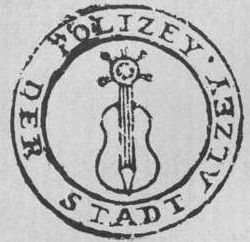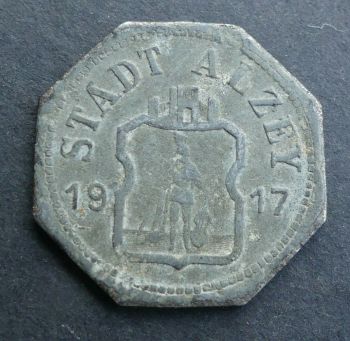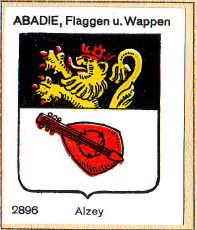Alzey: Difference between revisions
Knorrepoes (talk | contribs) m (Text replacement - "|Wappen von {{PAGENAME}}]]" to "|Wappen von {{PAGENAME}}/Coat of arms (crest) of {{PAGENAME}}]]") |
Knorrepoes (talk | contribs) m (Text replacement - "↵↵'''" to "'''") Tags: Mobile edit Mobile web edit |
||
| Line 1: | Line 1: | ||
'''ALZEY''' | '''ALZEY''' | ||
Revision as of 08:45, 27 December 2023
ALZEY
State : Rheinland-Pfalz
District (Kreis) : Alzey-Worms (until 1970 Alzey)
Additions : 1972 Dautenheim, Heimersheim, Weinheim
| German |
Geteilt von Schwarz und Silber, oben ein aus der Teilungslinie wachsender, rotbekrönter und rotbewehrter, goldener Löwe, unten eine schräg rechts gestellte rote Fidel. |
| English | blazon wanted |
Origin/meaning
Alzey became an important town in the 12th century when it became one of the residences of the counts of the Pfalz. In 1277 it became a city. The violin already appears in seals and images from the 13th century. The only known seal before 1277 only shows the lion of the Pfalz, indicating that the violin may be added at the time of granting of the city rights.
The first combination appears in 1478, where the lion holds the violin in its paws. Later again only the violin is used in the arms of the city. The present combination dates from 1908 and was officially granted in 1927.
| The arms on a municipal stamp (1892) |
The arms in the Kaffee Hag albums +/- 1925 |
| Emergency money 1917 |
The arms in the Abadie albums |
The violin is supposedly derived from the character Volker von Alzey in the Nibelungenlied.
The Nibelungenlied is a medieval German epic poem of unknown authorship, written in Middle High German in the early 13th century. The poem is a composite of Norse and Teutonic mythology and the early history of the kingdom of Burgundy. Several other versions exist of the material contained in the Nibelungenlied (Song of the Nibelungs). The principal one is the Icelandic prose epic Volsunga Saga (Saga of the Volsungs), which emphasises the mythological and primitive elements of the material common to both; the Nibelungenlied stresses the historical material. Parts of these two versions were used by the German composer Richard Wagner for his operatic tetralogy Der Ring des Nibelungen.
This page is part of the German heraldry portal Deutsche Wappensammlung |
Heraldry of the World |
|
German heraldry:
|
Selected collector's items from Germany:
|
Contact and Support
Partners:
Your logo here ?
Contact us
© since 1995, Heraldry of the World, Ralf Hartemink 
Index of the site
Literature: Stadler, 1964-1971, 8 volumes
















